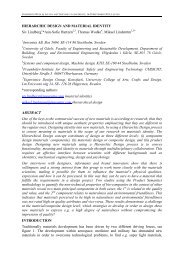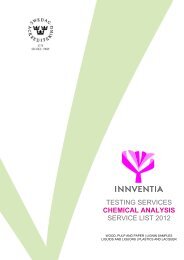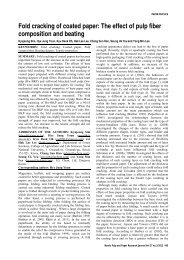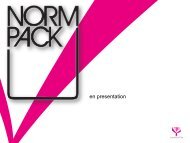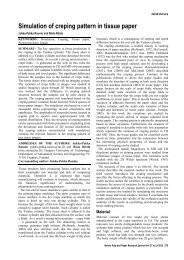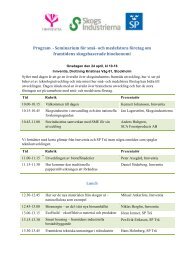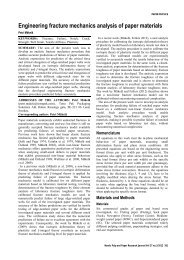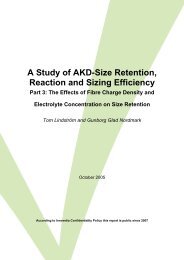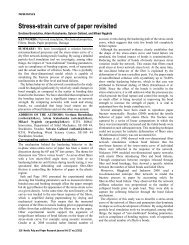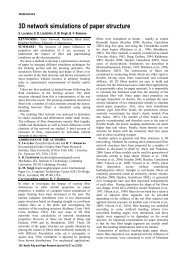Optical Calibration Laboratory Product Description - Innventia.com
Optical Calibration Laboratory Product Description - Innventia.com
Optical Calibration Laboratory Product Description - Innventia.com
You also want an ePaper? Increase the reach of your titles
YUMPU automatically turns print PDFs into web optimized ePapers that Google loves.
Page 2/4<br />
INNVENTIA AB<br />
<strong>Optical</strong> <strong>Calibration</strong> <strong>Laboratory</strong><br />
<strong>Product</strong> <strong>Description</strong> Oct 22, 2012<br />
reported on the calibration certificate only. The <strong>Optical</strong> <strong>Calibration</strong> <strong>Laboratory</strong> is accredited<br />
for both 10 and 20 nm data. 20 nm data are obtained by conversion from 10 nm data.<br />
The material in type D standards is non-fluorescent and has been specially chosen because of<br />
its insensitivity to UV radiation. <strong>Calibration</strong> can therefore be performed with any UV setting,<br />
for example UV(D65), UV(C) or UV excluded.<br />
IR3 type DX – spectral reflectance factor for spectrophotometers with<br />
extended wavelength range<br />
Type DX standards are intended for spectrophotometers having an extended wavelength<br />
range. These standards are made of the same paper as type D standards and have assigned<br />
spectral reflectance factor values for wavelengths between 360 nm and 740 nm.<br />
IR3 type DE – spectral reflectance factor for spectrophotometers with<br />
ERIC measurement option<br />
Type DE standards are intended for spectrophotometers equipped with a reflectance<br />
measurement channel at 950 nm. These standards are the same as type D, but the R950 value,<br />
the reflectance factor at 950 nm, is also assigned to these standards. Measurements at 950 nm<br />
are used for the determination of the effective residual ink concentration number, the ERIC<br />
number, of de-inked, recycled pulp and of sheets of machine-made paper made from recycled<br />
pulp.<br />
IR3 type F – fluorescent standards for illuminant D65<br />
Type F fluorescent standards have an assigned CIE whiteness (D65/10°) value, for the UV<br />
filter in the spectrophotometer to be adjusted so that the illumination corresponds to<br />
illuminant D65. The instrument must first be calibrated with a non-fluorescent standard. The<br />
whiteness of the fluorescent standard should then be measured, and the UV filter adjusted<br />
until the correct value is obtained.<br />
IR3 type B – fluorescent standards for illuminant C<br />
Type B fluorescent standards have an assigned ISO brightness R 457 (illuminant C) value, for<br />
the UV filter in the spectrophotometer to be adjusted so that the illumination corresponds to<br />
illuminant C. The instrument must first be calibrated with a non-fluorescent standard. The<br />
brightness of the fluorescent standard should then be measured, and the UV filter adjusted<br />
until the correct value is obtained.<br />
IR3 type FB – <strong>com</strong>bined fluorescent standards for illuminants D65 and C<br />
Type FB standards are a <strong>com</strong>bination of type F and B standards. Each standard has two<br />
assigned values, a CIE whiteness value for the adjustment to illuminant D65 and an ISO<br />
brightness value for the adjustment to illuminant C.<br />
IR3 type Zxx – for filter instruments Zeiss Elrepho and Technidyne micro-<br />
TB-1C<br />
Type Z standards are intended for filter instruments. Each standard has assigned R x , R y , R z and<br />
R 457 values for calibration of the corresponding filters in these instruments. Type Z standards<br />
are available at 6 different reflectance levels, having nominal R 457 values of 90%, 80%, 70%,<br />
60%, 50% and 20% – Z90, Z80, Z70, Z60, Z50 and Z20.



